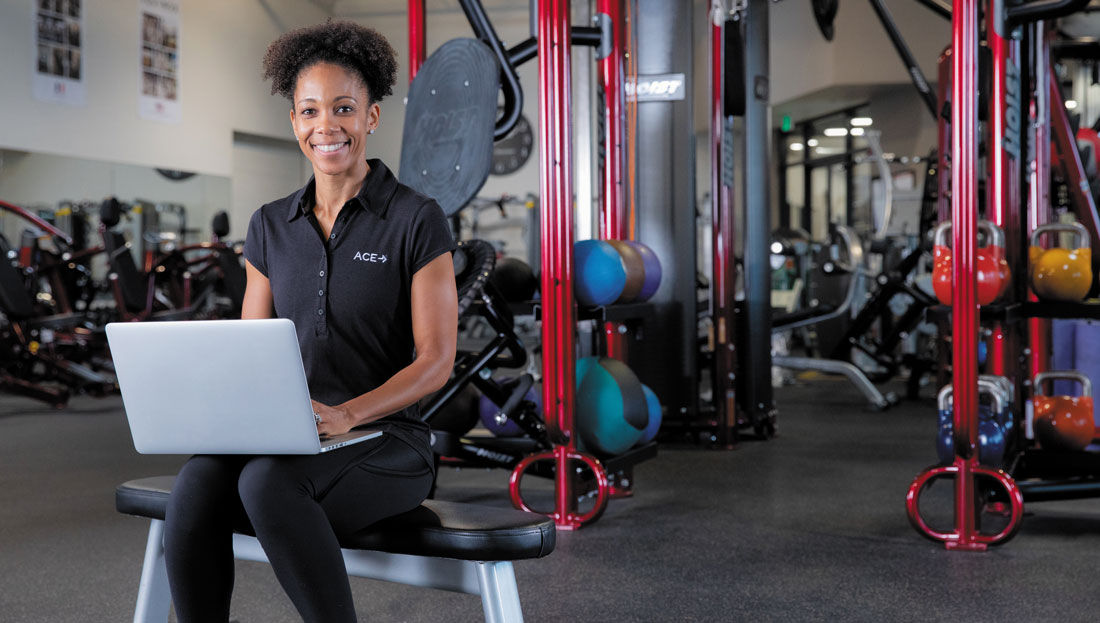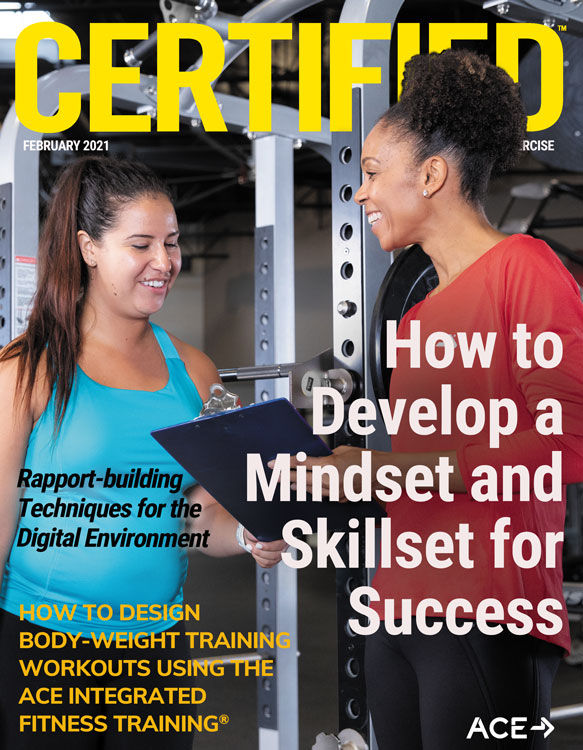
The health and fitness industry has faced and overcome significant challenges in the past year. The COVID-19 pandemic has changed the way we live and work. While change is a phenomenon we naturally face over time, the changes that accompanied this pandemic were swift and drastic. Health and exercise professionals have reimagined their services, reconfigured their studios and redefined client interactions to keep people moving in thoughtful and intentional ways.
Part of this change process has challenged health and exercise professionals like you to cultivate rapport in a virtual environment while still delivering a quality exercise experience for their clients. The digital experience is not the same as it would be in a face-to-face environment—in fact, it’s not meant to be. The digital world offers unique challenges, but with intention and invention we can create and strengthen bonds with our clients. Here’s how to build rapport in the virtual world of health and fitness.
Shifting Mindset: It Starts Here
As an educator and health and exercise professional, I hear many bemoan the fact that teaching, learning and training aren’t the “same” or as “easy” as they would otherwise be in a face-to-face environment. Too many professionals end up falling into the comparison trap and neglect to see the virtual environment for all of its positive aspects and opportunities. The two just aren’t meant to be compared. Each offers unique strengths and benefits as much as they do challenges and learning curves. It’s less about where the experience takes place (online or offline) and more about how you are able to leverage those strengths and address those challenges that shape the experience.
As health and exercise professionals, we need to make our virtual platform the “norm” rather than the exception to doing business and serving clients. Practicing in a digital environment isn’t necessarily difficult, but it is different, which is important to acknowledge. But different doesn’t mean lesser or harder. Rather, it requires us to adapt and deliver quality content with a flare or two of creativity.
The lesson here: digital is different, not difficult.
A 5-ingredient Recipe for Rapport
Establishing rapport involves building a relationship of trust and mutual understanding. Just because the client-coach or client-trainer relationship is born through a digital experience does not change the ability you have as the professional to establish a trusting camaraderie. Building relationships is less about where they started and more about the intention behind each individual’s actions. Is each individual consciously making deposits into the relationship? Let’s look at rapport and the qualities you can display to effectively enhance rapport from the first meeting.
Authenticity. For any relationship to flourish—professional or otherwise—each person must act in ways that are congruent with their values and beliefs. When we behave authentically, we cultivate a sense of trust in those we serve. The more trust we cultivate, the more our clients can connect with us as professionals and as people.
Curiosity. Our clients have busy lives. They want to be seen as whole people who come to you not only with a set of health and fitness goals, but as people who also experience joy, sadness, stress and success. We must be curious about the lives our clients lead and how their daily experiences positively influence or detract from their progress toward their goals. Seek to understand your clients on a personal level (while remaining within your scope) and invest in them as individuals.
Communication. How you communicate (both verbally and nonverbally) can determine the course of your relationships with clients from the first interactions you have with them. While nonverbal communication is not as obvious or as easily observed in a digital environment, that doesn’t mean it isn’t possible to communicate effectively. An effective coach actively works to blend both styles of communication into each interaction, which leads to a growth in rapport.
Consistency. Consistency in communication, action and intention are signs of professionalism. As a health and exercise professional, you can foster rapport by being consistent in your client interactions, follow-ups, programming efforts, session quality, organization skills and communication. Consistency builds credibility and, therefore, rapport.
Presence. For trust to build and rapport to grow, you must be present in all interactions with your clients. This means limiting distractions as much as possible. Make sure your virtual workspace isn’t cluttered or chaotic in its design and that you place your phone, watch and computer on “airplane” or “do not disturb” mode so that incoming calls, texts and other messages can’t threaten to pull your focus. Being present also means mirroring your client. Work to match a client’s tone of voice, speed of talking and nonverbal cues (e.g., body language).
Nothing can or will replace a well-timed high five, a pat on the back or a genuine “I’m proud of you” hug with your clients. It’s critical to acknowledge that building rapport in a digital environment will look and feel different but be no less meaningful or effective if you are thoughtful and intentional in the ways in which you approach the process.
Further, it’s important to keep in mind that “digital environment” refers to more than just the live interactions you have with clients via Skype, Zoom, FaceTime or any other video-conferencing platform. The digital environment encompasses all the work you do in an asynchronous fashion as well, such as email, texts and social media messages.
Consider applying the following actionable steps to facilitate the rapport-building process while serving your clients in a virtual world.
1. Schedule a “meet and greet” with potential clients.
When working with a new client, schedule a no-cost meet-and-greet session. This session should be designed as a get-to-know-you conversation during which you establish a connection and explore the client’s likes, dislikes, personal details, work life, etc. If the client is new to exercise or to digital experiences, this session gives them the opportunity to communicate their apprehension or concerns, while you have the chance to provide reassurance. During this session, give the client a tour of your virtual space and examine what space they have at home to perform workouts. If you conduct this type of session, be sure to approach it in an organized but relaxed manner. You may want to prepare a set of questions or talking points and a general process to follow so you are consistent with each client. This type of interaction will help the client feel more comfortable and connected to you even if it’s at a distance.
You can do the same for clients who are transitioning from a face-to-face personal-training experience to a virtual environment. This works well for established clients who may be facing a move or other geographical barrier that prevents them from working with you.
2. Be mindful of nonverbals.
Body language reflects the words we don’t say and the emotions we don’t express openly. It’s critical to be aware of how we present ourselves in the digital environment, in both live and asynchronous formats.
We know that posture, hand gestures, eye contact and arm position speak volumes to our clients. But elements such as vocal variety (volume, tonality, speed, use of pauses, etc.), the professional’s attire and appearance and punctuation in written communication also have considerable impact on the rapport-building process.
In a live digital interaction through a video-conferencing platform, you and your clients can convey emotion and tone of voice throughout the conversation. These elements of nonverbal communication are generally lost in asynchronous interactions. If meeting virtually, as opposed to communicating via email or text, you can hear your client’s tone of voice shift and can more easily observe facial expressions and general body language (shoulders slumped, arms crossed, downward gaze, etc.).
Here’s an example of how powerful visual interactions can be, even on a digital platform: A client shares with their personal trainer that they just achieved a personal best on their last run. The professional can celebrate with the client in that exact moment and offer praise and words of excitement in a synchronous fashion. Both parties can observe facial expressions and excited body language (clapping hands, upright posture, jumping up and down, etc.). Emotion is both seen and felt. This isn’t as easily translatable to a written interaction.
In contrast, when communicating via text or other written forms, emotion can be lost and less easily interpreted, and intention may even be misinterpreted. For example, a text or email from a client that says, “Thank you,” as opposed to “Thank you!” lands differently in the mind of the recipient. In this example, punctuation is key to conveying meaning and emotion. The lesson: It isn’t just the content of the message that matters; it’s the way in which we write it. Invest time and effort into crafting texts and emails in such a way that you prioritize the recipient’s potential reaction.
Keep these practical tips in mind for live interactions and written digital communications with clients:
- Start and end with a smile (this conveys warmth and an energetic attitude).
- Vary your tone of voice and speak clearly.
- Limit distractions.
- Display upright posture and face the camera.
- Maintain eye contact during conversations by looking into the camera.
- Try to keep hand gestures modest (don’t gesture so large that your hands go off screen).
- Practice email and text etiquette.
- Use well-placed and appropriate emoticons in written communications.
3. Connect through video.
Another approach to building rapport in a digital environment is to utilize video features to communicate with clients. There are many easy ways to record a quick video to provide feedback and encouragement to clients. For example, if your client turns in a weekly food log, instead of writing an essay in an email, record a quick video to reinforce what they did well and ask about their goals for the next week. You could do the same if a client recorded an at-home workout or an on-the-road routine during a time of travel. Responding by video allows you to convey excitement and emotion, while providing feedback on their form and, if needed, demonstrations of exercises if the client’s form was off.
Beyond giving form feedback, you can utilize video responses to provide messages of encouragement or “tips of the week.” A 30-second video to say something like, “Good morning! This is just a quick message to say I am excited to see you for our noon session. I have some fun activities planned and am looking forward to sharing them with you. See you soon!” connects with clients differently than an email or text. This way, a client can see your face, hear your voice and interpret your excitement. It’s a response that is both personalized and intentional.
4. Leverage social media to connect with followers.
Social media is an easy-to-use platform for delivering quality content, both live and asynchronously. To leverage this tool, you should have a consistent online presence and engage with your clients. Yes, it’s important to distribute quality content, but it’s equally important to use your social media presence to get to know your clients, celebrate their wins, provide insight and guidance, establish a connected community and foster social support.
One way to approach this is to actively engage your clients and followers in a conversation. Pose a question asking for assistance and their insight. For example, share a post with a call to action such as, “What’s your favorite go-to lean protein?” or “Share your top two best meal-prep tips to reduce time in the kitchen.” Clients and followers will be called to answer and actively engage. The bonus: They learn from each other and start building connections amongst the group.
Second, share your human side. Take a minute to jump on Facebook Live or Instagram TV and give your clients a tour of your kitchen or share a favorite recipe. You can also use this as an opportunity to share a struggle you’ve had—maybe it’s not sleeping well or lacking motivation. Allow them to see you as a person and not just as an “expert.” Clients connect better with you when they know you are fallible and make mistakes, too.
Third, create and share quality content. Whether it’s in the form of a short blog post or video, an exercise of the day or an image, be sure to connect it with your brand and actively engage users with the content. You could also share user-generated content and highlight client successes (with their approval, of course).
Invest time in getting to know each client to determine what forms of communication work best for them and what makes them feel connected to both you as their health and exercise professional and to the overall virtual experience. Adjust your approach to meet the needs of each client and reevaluate your process over time. The cornerstone of a successful and long-standing client-coach relationship is the presence of rapport.





 by
by 


